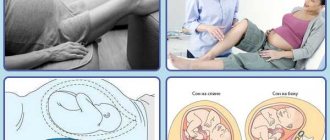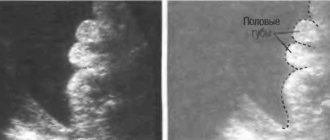Many parents believe that the baby needs communication already during the period of intrauterine development, so the mother sings him lullabies, and the father tells him fairy tales. As research shows, these touching scenes do not contradict the facts: the baby really hears sounds and reacts to them, so you can and should talk to the child. Let's figure out how long it takes for a fetus's hearing to develop, what sounds bring joy to the baby, and whether he will be able to remember voices and music when he is born.
When do newborns begin to hear?
There is an opinion that the baby does not hear anything in the first few days. The reason is the presence of fluid in the inner ear.
Expert opinion
Anastasia Mikhailovna Moiseeva
Practicing general practitioner, 18 years of experience.
This opinion is wrong. Literally from the first minutes, the infant begins to hear, although only loud and sharp sounds. He does not respond to calm music or a working TV.
Newborns are able to distinguish human voices from other sounds.
The most pleasant is the mother's voice .
Kids distinguish between intonation, speed of speech, and voice timbre. They begin to cry sharply, tremble, and remain warily silent.
If the child’s reaction to the sound is not initially observed, there is no need to panic. He will begin to react consciously only by the third month of life.
Parents can make sure there are no deviations at home. The first tests are carried out a week after birth.
What is the normal reaction
Common reactions are:
- Movement of arms and legs
- Head turns
- Finding the source of the voice with your eyes
- Freezing or flinching
- Cry
- Listening
If these reactions are absent in the first month of the child’s life with background sounds, do not be nervous, this is completely normal. But if the baby does not react even to loud and prolonged sound stimuli, this is a reason to see a specialist. Fortunately, only 1-2% of 1000 newborns have hearing loss.**
How is diagnostics carried out?
Methods for determining hearing are combined under one name - audiological screening.
Diagnosis is carried out using special devices, as well as by observing the baby’s reaction. Parents can try some techniques at home, without the help of specialists.
Methods for developing vision in newborns
Adaptation of the visual organs to the surrounding world occurs quite quickly, and it can be accelerated with the help of game exercises.
- At first, you need to walk in front of your child wearing clothes with black and white or contrasting stripes, triangles, circles or other simple geometric patterns.
- At a distance of 0.3 m from the baby’s face, you need to actively grimace so that he begins to recognize facial changes on the main visual object - the mother’s face.
- During feeding, you can wear a necklace made of bright large beads, which will arouse interest, but will not distract the baby from satisfying his hunger.
- Having taken a bright toy, you need to move it in front of the child’s eyes and monitor the reaction.
- You need to hang a garland of bright toys above the crib. It's worth starting with two-color objects, for example, red and green, and as you develop, you can add other toys. It would be good if they made some melodic sounds.
Diagnostic methods in the maternity hospital
In the first month of life, basic diagnostic measures are performed. The procedure is carried out using a device in the maternity hospital.
The duration of the examination is a maximum of five minutes . It can be performed when the newborn baby is sleeping.
The otoacoustic emission method is used. If the results are in doubt, auditory evoked potentials are additionally recorded.
A special device is used to test the reaction to sound sensations.
Effective techniques:
- fixation of otoacoustic emissions;
- behavioral audiometry;
- impedancemetry;
- registration of KSVP (ABR method).
Determination of brain response (ABR)
The diagnostic method involves capturing impulses from wax cells located inside the cochlea. The auditory nerve responds to sound stimuli.
The device is a sensor with electrodes attached to a computer. The received information is visualized and processed on the PC.
The response to the sound signal is the generation of pulses recorded by the device. Monochromatic sounds and clicks are heard. The result is transferred to the monitor . A graphical curve appears there that allows you to evaluate the results.
Inner ear examination (UAE)
Otoacoustic emissions are sound generated by the hair cells of the cochlea. It is divided into spontaneous, which occurs in the absence of sounds, and caused, which manifests itself under the influence of stimuli.
In diagnosis, induced OAE is used. The technique is considered a mandatory examination when testing a baby’s hearing.
The absence of otoacoustic emissions often indicates a problem. Once the result is received, additional tests are prescribed.
Impedancemetry
Testing is carried out by placing a special device into the external auditory canal. The pressure is measured, the device perceives the sound reflected from the membrane.
Additionally, contractions of the stapedial muscle responding to the sound signal are recorded.
Secrets of taste
9 weeks
The fetus develops taste buds on the tongue and develops taste sensitivity. The fetus swallows amniotic fluid, and its composition and, accordingly, taste changes depending on the conditions. So, for example, if something bitter gets into the amniotic fluid, for example, a disinfectant that is used when collecting amniotic fluid, the baby begins to wince, sticks out his tongue, and makes fewer swallowing movements, as if he is trying to spit out something he doesn’t like. But the introduction of glucose into the amniotic fluid accelerates the swallowing movements of the “sweet tooth.” What the mother eats also enters the amniotic fluid in microdoses. And if a pregnant woman eats, for example, garlic or lemon, the taste of the water becomes more bitter or sour, causing the baby to wrinkle.
Even before birth, a mother can accustom her child to her favorite dishes, even if they have a specific taste. So, for example, if dishes with garlic are part of your daily diet, you shouldn’t give them up completely. Over time, the baby will get used to them and begin to perceive them calmly. There are facts confirming that after birth a child often shows preferences for those dishes that the mother loved to eat during pregnancy.
Hearing test at home
Parents can independently check their baby’s hearing at 1 month. To do this, you need to discreetly approach the baby with an unfamiliar sound source (pipe, bell) and observe the reaction.
You can do this when the baby has just fallen asleep . But you can’t make loud sounds: they can scare the baby. All you have to do is cough and rub your hand against your hand.
A normal reaction would be when the baby:
- will wake up;
- opens his eyes wide;
- will begin to move his arms and legs;
- sigh;
- will change his facial expression.
From two months the baby begins to make the first sounds, and from four months he is able to react joyfully when he hears the sound of his favorite musical toy. With normal auditory perception, skills are constantly improved.
Touch everything
7.5 weeks The fetus develops skin sensitivity. First, it appears in the mouth area - this is preparation for the formation of the sucking reflex. From 8 weeks, the baby’s face and palms become sensitive, and from 10 weeks – the entire surface of the body. In the mother's tummy there is a lot of material for the baby to develop tactile sensations. With the help of ultrasound, you can see how the baby touches his own body, the umbilical cord, and the walls of the amniotic sac. The child begins to use his sensitivity not only to study the internal space of the uterus, but also to master the external world. If the mother puts her hand to her stomach, the baby tries to touch her “from the other side.” In the same way, even before birth, a child can “get to know” both his father and his brothers and sisters. The fetus also reacts very interestingly to the ultrasound sensor: at first, feeling the touch of an unfamiliar cold object, it tenses and moves to the side, but then, if the mother does not worry and relaxes, it calms down and begins to study the new object - it tries to touch the sensor with its palms or heels.
From the second half of pregnancy, when you already feel the baby moving, you can arrange a “mother’s session” for him. At the same time of day, place your hands on your stomach and sing a lullaby or any children's song to your baby. At this time, the baby will try to touch your hands “from the other side.” Every day you need to sing the same song - then the baby will get used to it and after birth he will recognize it and calm down when he hears a familiar melody. Such a session should last no more than 10 minutes so that the child does not get tired, but this must be done daily. You can arrange not only mom’s, but also dad’s “session”.
Additional techniques
This task of testing a newborn’s hearing can be done at home using simple methods.
Moro reflex
Using this method, it will not be possible to determine the threshold hearing. The method allows you to exclude severe degrees of hearing loss.
The procedure is carried out as follows:
- The baby is placed on a flat surface, with his legs and arms straightened. It is impossible to force a baby to straighten up.
- Clap your hands at a distance of about 20 cm from the ear. The response to a loud sound is to flinch, cry, and the baby spreads its fingers.
- The second ear is checked in the same way.
Kalmykova method
The method makes it possible to determine the child’s sensitivity to high and mid tones.
The following actions are performed:
- Take three plastic jars. Fill each of them one third with different cereals (peas, buckwheat, semolina).
- One parent attracts the baby's attention, the other stands out of sight with the prepared props.
- At a distance of about 10 cm from the child’s ear, first shake the container with semolina. This produces high-frequency sounds.
- Testing is carried out with two other containers.
A newborn baby will only hear the sound of a jar filled with peas. He will freeze or flinch for a while. The child hears the sound of smaller cereals well closer to six months.
If the baby does not respond to the container with peas, it is recommended to re-test after a few days. If there is no positive dynamics, you should consult a doctor.
Always in moving
6–7 weeks The little man already has his first sense organ – the vestibular apparatus. It helps maintain body balance even in unsupported spaces. The child spends his entire intrauterine life in motion: firstly, he constantly moves himself (observing the development of the fetus using ultrasound, you can see that he never remains motionless); secondly, the mother also moves, and the baby moves with her relative to the earth's axis. This is the first information about the outside world that the fetus receives. By the end of the intrauterine period, the child masters the mother’s movements so well that he distinguishes when she is calm, when she is excited, when she is tense, and also reacts to this with her movements.
The baby responds very well if he is moved in space (after all, he is so used to this after 9 months!). He quickly calms down when he is carried in arms or carried in a stroller. Parents often ask the question: is it necessary to rock a child so that he calms down and falls asleep? Yes, if he needs it, because movement is a normal state for a baby.
Signs of good hearing
Understanding what a baby hears is quite simple: a few weeks after birth, he begins to flinch when he hears loud sounds.
A one-month-old baby concentrates and freezes when they start talking to him .
He becomes animated when he hears his mother’s voice and tries to turn toward the sound. From three months, the baby begins to react negatively to sharp sounds. The ringing of the phone, the noise of the vacuum cleaner provokes flinching, widening of the eyes, crying, screaming.
An indicator of the absence of hearing problems is babbling and humming. A four-month-old baby babbles when he sees his loved one. Gradually the baby begins to pronounce syllables.
A child with poor hearing also babbles, but no further development of speech is observed.
At what age do children begin to hear?
For two to three days, the baby's inner ear is filled with fluid, which softens the perception of sounds that hit him after birth.
Although the auditory nerve is fully developed by the age of one, a newborn has good hearing and is able to detect intonation, voice timbre, and speech rate. His reaction can be easily seen by his animation:
- the baby actively moves his legs and clenches his fists;
- looks for the source of sounds with its eyes;
- freezes or flinches;
- cries if the sound is too strong or unexpected.
Sometimes babies experience jerky movements. At an early age, experts do not consider such a reaction to be a deviation.
This just means that the baby has a fairly high level of sensitivity, which is why you should communicate with him in a quiet, even voice.
A two-month-old baby begins to react to what is happening in a more orderly manner - convulsive movements disappear, he turns his head towards the source of the noise.
When talking to him, pay attention:
- if you speak quickly, the child becomes restless and his movements speed up;
- if you speak smoothly and slowly, the baby calms down and his movements also slow down.
Sometimes children, captivated by toys, do not pay attention to extraneous sounds. In addition, do not forget that each child is individual, so even pediatricians warn that it is difficult to predict exactly how a baby will react to noise.
Doctors advise not to worry ahead of time if it seems to you that the newborn is not distracted by sound stimuli. Probably, a calm and phlegmatic baby was simply born into your family.
Alarming symptoms
You should immediately consult a doctor if you have the following problems:
- a newborn at two to three weeks does not flinch from loud sounds;
- a month-old baby does not turn his head to sounds coming from behind him;
- it is impossible to calm a three-month-old baby with a mother's voice;
- at 4 months there are no attempts to imitate voices or sounds.
Such alarming symptoms cannot be ignored. Need specialist advice.
I see the light!
25 weeks The baby’s vision organs begin to function. Of course, in the uterus the mother does not have much information for the development of vision, but this is quite enough for the baby. It has been proven that the fetus already has light perception. So, he sees sunlight in muted orange tones and reacts positively to scattered rays, and hides from direct rays, squinting his eyes.
Even before birth, the baby likes sunlight, he can distinguish it, even if the mother is wearing light clothes. Therefore, in warm weather it is necessary to be in the fresh air (this, by the way, will also be a good prevention of rickets). But you should not expose your child to sunlight for too long, as this tires and overstimulates him.
The first month of a child's life
A newborn baby is a child under 1 month of age. For parents, the newborn period of a child usually flies by in just one minute. It seems that they just picked up the mother and baby from the maternity hospital, received congratulations, bought everything they needed, met the visiting nurse and the doctor - and now the baby is already a month old. But how many new things should young parents learn this month, how many necessary and useful skills should they learn. So, in terms of importance and intensity, the first month of a child’s life is perhaps the most significant, both for him and for mom and dad.
During the first month of a child's life, his body adapts to existence outside the warm and cozy mother's womb. Especially in the first week after birth, the child’s body spends a lot of energy on this adaptation, so in the first days the child, as a rule, loses about 400 g of weight (up to 10% of body weight). By the beginning of the second week, the baby begins to gain weight. Normally, the daily increase is 20-30 g, i.e. in the first month of life, the child should gain about 500 g. It’s good if you have special baby scales at home to control. However, by the end of the first month you will have to visit the clinic with your baby, and there a pediatrician will weigh the baby. He also measures the baby (in the first month the baby should grow by 3 cm, and the circumference of the chest and head should increase by 1.5-2 cm).
walking reflex - if you hold the baby by the arms vertically above a hard surface, when his feet touch this surface, he will make movements with his legs that imitate walking.
The presence of these and some other reflexes in your newborn baby will be checked by a visiting nurse and a pediatrician, who should come to your home every week for the entire first month of the child’s life. This is necessary to control its development.
newborn hoarseness from crying what to do A hoarse voice in a baby is a phenomenon that will alert any caring parent. After all, any mother can distinguish the cry of her child and will certainly be able to distinguish a simple roar from an unhealthy wheeze. Often
newborn is not yet conscious
Source
Preferred music
Music that brings pleasure to the mother is not always to the baby’s liking, but there are certain genres to which all children react in the same way: classical music, lullabies, operas, calm romances and folk songs evoke positive emotions in the fetus: it calms down and listens carefully to a melody he liked. A negative reaction will immediately appear to the roar of rock music, rhythmic and loud pop compositions: at these sounds, babies begin to push vigorously, sometimes with their extreme activity they force their mother to turn down the sound or leave the concert. Therefore, when turning on the next composition for your baby, focus on his behavior: he will behave calmly when he likes the music, and actively push when this or that melody is unpleasant to him.
As a rule, children who listened to classical music before they were born were subsequently far ahead of their peers in mental development.
When choosing music to listen to together with your baby, you must remember that the baby’s body will, first of all, react to the frequency, tonality and rhythm of the melody. The latter should not be higher than the heartbeat frequency - then the music will calm and delight the child. If this is relaxing and soothing music for pregnant women, you can turn it on at a low volume and place the playback device on your tummy: the baby will quiet down and soon fall asleep with the mother. It is also convenient to listen to music on headphones by adjusting the volume: the baby will be able to perceive the melodies in the same way as the mother.
It is advisable that listening to music at a time does not exceed more than half an hour. The best period for music sessions is the morning awakening and the time before bed. A baby reacts to music in the same way as an adult: sad melodies evoke a similar mood in him, but cheerful major notes can have an exciting effect on him. Therefore, classical works are considered the best option for the fruit, since they usually ideally combine both elements.
In addition to speech, the fetus perfectly senses the mother’s mood: when she is upset or excited, her heart and pulse beat with redoubled force, her breathing becomes irregular, and her tone of voice is distorted. At these moments, the child becomes quiet, as if sensing danger.
How does the hearing aid develop?
In accordance with the norms of fetal development, a tiny person in the womb, at about the seventh week, two barely noticeable tubercles appear on the sides of the head. These are the future ears that we can see on every person. However, the inner ear begins to develop 14 days earlier. This occurs in the fifth week, and in the eighth week the formation of the middle ear begins. The process of development of the structure of the hearing aid lasts until the beginning of the fifth obstetric month. At about 18 weeks of age, your baby's ear labyrinth becomes hard.
The influence of different music on the fetus of a child
Classical music, fairy tales, poems, and sounds of nature have a positive effect on the baby’s nervous system during the period of intrauterine development and give him extensive information about the world. Harmonious, beautiful and calm melodies are useful for both mother and baby, as they contribute to their emotional relaxation. The sound of melodic instrumental compositions already during this period instills in the child musical abilities, a craving for beauty and good taste.
But loud music is extremely undesirable for the baby, since sound exceeding ninety decibels is very difficult for the fetus to perceive. It is not surprising that the powerful compositions of rock singers meet with such disapproval from the little one.










